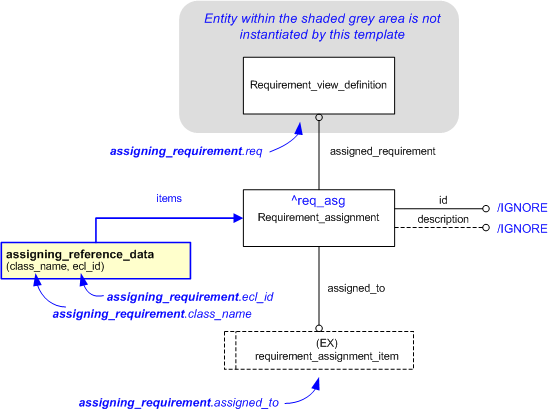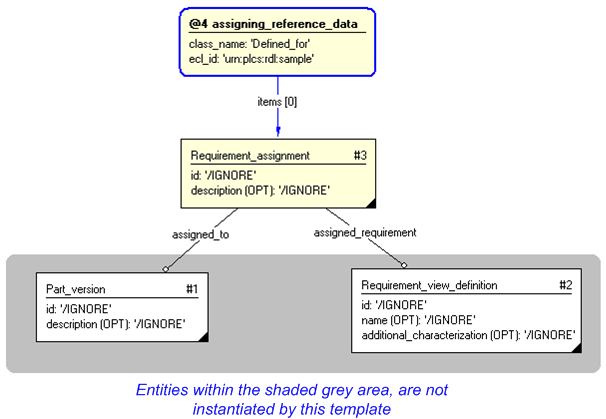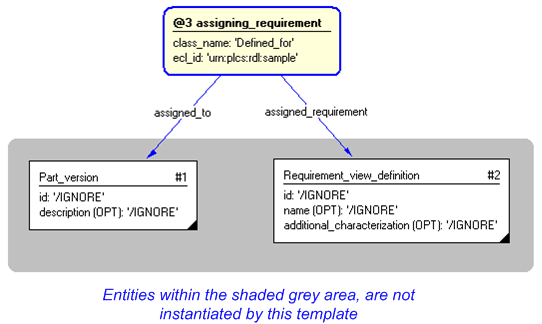Template:— assigning_requirement (asg_req)
Capability:representing_requirements |
Date: 2011/04/21 11:56:48
Revision: 1.3
|
This section specifies the template assigning_requirement.
NOTE
The template has been defined in the context of the capability
representing_requirements
which provides an overall description of the
relevant parts of the ISO 10303-239 information model and a description
of related templates.
NOTE
An explanation of a template and the associated instantiation path is
provided in the
Template overview
section.
This template describes how to represent the assignment of a requirement to an entity within a data set.
The meaning of the assignment is provided by classification.
The EXPRESS-G diagram in
Figure
1
shows the templates and EXPRESS entities that are required
to represent the template
"assigning_requirement".
The text highlighted in blue shows the template parameters.
Figure 1 — An EXPRESS-G representation of the Information model for assigning_requirement
The graphic for the template to be used in other EXPRESS-G diagrams
is shown in Figure
2
below.
Figure 2 — The graphical representation of the assigning_requirement template
The following input parameters are defined for this template:
The name of the class
(
External_class)
being used to determine role of the requirement assignment.
The following classes and their sub-classes can be used:
ecl_id (Default=urn:plcs:rdl:std,Type='URN')
The requirement being assigned.
The entity to which the requirement
is assigned.
The following reference parameters are defined for this template:
Allow the
Requirement_assignment
entity instantiated in this path to be referenced when this template is used.
%^target = $assigning_requirement.req_asg%
The instantiation path shown below specifies the entities that are to be
instantiated by the template.
A description of templates and the syntax for the instantiation path is
provided in the
Templates Help/Information section.
The following entities are instantiated with attributes as specified:
The instance diagram in Figure
3
shows an example of the EXPRESS entities and templates that are instantiated by the template:
/assigning_requirement(assigned_to='#1', assigned_requirement='#2', class_name='Defined_for', ecl_id='urn:plcs:rdl:sample')/
(an illustration of the consolidated assigning_requirement template is shown in
Figure
4 below.)
Figure 3 — Entities instantiated by assigning_requirement template
The instance model in STEP ASCII exchange file format (ISO 10303 Part
21 syntax) is:
#1 = PART_VERSION('/IGNORE','/IGNORE',$);
#2 = REQUIREMENT_VIEW_DEFINITION('/IGNORE','/IGNORE','/IGNORE',$,(),$);
#3 = REQUIREMENT_ASSIGNMENT('/IGNORE','/IGNORE',#2,#1);
#5 = CLASSIFICATION_ASSIGNMENT(#6,(#3),'/IGNORE');
#6 = EXTERNAL_CLASS('/NULL','Defined_for','/IGNORE',#7);
#7 = EXTERNAL_CLASS_LIBRARY('urn:plcs:rdl:sample','/IGNORE');
The instance diagram in
Figure
4
shows the graphic symbol for the template that is to be
used in other instance diagrams. The example template is:
/assigning_requirement(assigned_to='#1', assigned_requirement='#2', class_name='Defined_for', ecl_id='urn:plcs:rdl:sample')/
Figure 4 — Instantiation of assigning_requirement template
Characterizations
No common characterizations of the template
assigning_requirement
have been identified. However, the ISO 10303-239 EXPRESS model
may enable other assignments to the entities instantiated by the template.




